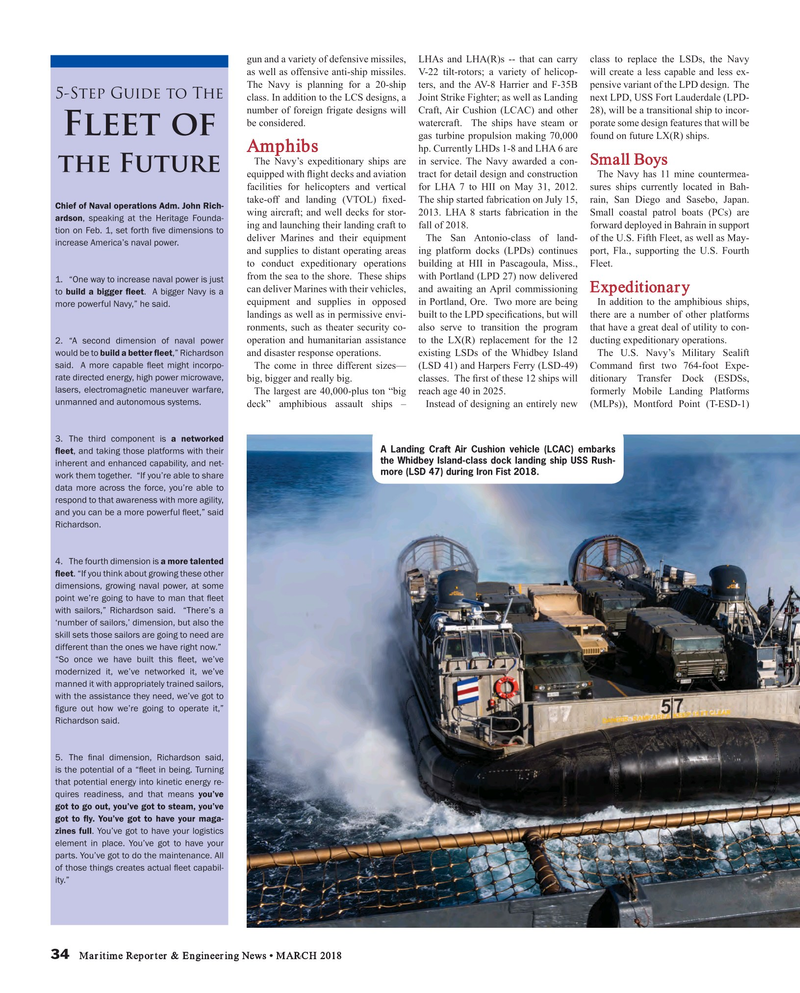
Page 34: of Maritime Reporter Magazine (March 2018)
Annual World Yearbook
Read this page in Pdf, Flash or Html5 edition of March 2018 Maritime Reporter Magazine
gun and a variety of defensive missiles, LHAs and LHA(R)s -- that can carry class to replace the LSDs, the Navy as well as offensive anti-ship missiles. V-22 tilt-rotors; a variety of helicop- will create a less capable and less ex-
The Navy is planning for a 20-ship ters, and the AV-8 Harrier and F-35B pensive variant of the LPD design. The 5-Step Guide to The class. In addition to the LCS designs, a Joint Strike Fighter; as well as Landing next LPD, USS Fort Lauderdale (LPD- number of foreign frigate designs will Craft, Air Cushion (LCAC) and other 28), will be a transitional ship to incor- be considered. watercraft. The ships have steam or porate some design features that will be
Fleet of gas turbine propulsion making 70,000 found on future LX(R) ships.
Amphibs hp. Currently LHDs 1-8 and LHA 6 are
The Navy’s expeditionary ships are in service. The Navy awarded a con- Small Boys the Future equipped with ? ight decks and aviation tract for detail design and construction The Navy has 11 mine countermea- facilities for helicopters and vertical for LHA 7 to HII on May 31, 2012. sures ships currently located in Bah- take-off and landing (VTOL) ? xed- The ship started fabrication on July 15, rain, San Diego and Sasebo, Japan.
Chief of Naval operations Adm. John Rich- wing aircraft; and well decks for stor- 2013. LHA 8 starts fabrication in the Small coastal patrol boats (PCs) are ardson, speaking at the Heritage Founda- ing and launching their landing craft to fall of 2018. forward deployed in Bahrain in support tion on Feb. 1, set forth ? ve dimensions to deliver Marines and their equipment The San Antonio-class of land- of the U.S. Fifth Fleet, as well as May- increase America’s naval power.
and supplies to distant operating areas ing platform docks (LPDs) continues port, Fla., supporting the U.S. Fourth to conduct expeditionary operations building at HII in Pascagoula, Miss., Fleet.
from the sea to the shore. These ships with Portland (LPD 27) now delivered 1. “One way to increase naval power is just
Expeditionary can deliver Marines with their vehicles, and awaiting an April commissioning to build a bigger ? eet. A bigger Navy is a equipment and supplies in opposed in Portland, Ore. Two more are being In addition to the amphibious ships, more powerful Navy,” he said.
landings as well as in permissive envi- built to the LPD speci? cations, but will there are a number of other platforms ronments, such as theater security co- also serve to transition the program that have a great deal of utility to con- operation and humanitarian assistance to the LX(R) replacement for the 12 ducting expeditionary operations. 2. “A second dimension of naval power would be to build a better ? eet,” Richardson and disaster response operations. existing LSDs of the Whidbey Island The U.S. Navy’s Military Sealift said. A more capable ? eet might incorpo-
The come in three different sizes— (LSD 41) and Harpers Ferry (LSD-49) Command ? rst two 764-foot Expe- rate directed energy, high power microwave, big, bigger and really big. classes. The ? rst of these 12 ships will ditionary Transfer Dock (ESDSs, lasers, electromagnetic maneuver warfare,
The largest are 40,000-plus ton “big reach age 40 in 2025. formerly Mobile Landing Platforms unmanned and autonomous systems. deck” amphibious assault ships – Instead of designing an entirely new (MLPs)), Montford Point (T-ESD-1) 3. The third component is a networked
A Landing Craft Air Cushion vehicle (LCAC) embarks ? eet, and taking those platforms with their the Whidbey Island-class dock landing ship USS Rush- inherent and enhanced capability, and net- more (LSD 47) during Iron Fist 2018.
work them together. “If you’re able to share data more across the force, you’re able to respond to that awareness with more agility, and you can be a more powerful ? eet,” said
Richardson.
4. The fourth dimension is a more talented ? eet. “If you think about growing these other dimensions, growing naval power, at some point we’re going to have to man that ? eet with sailors,” Richardson said. “There’s a ‘number of sailors,’ dimension, but also the skill sets those sailors are going to need are different than the ones we have right now.” “So once we have built this ? eet, we’ve modernized it, we’ve networked it, we’ve manned it with appropriately trained sailors, with the assistance they need, we’ve got to ? gure out how we’re going to operate it,”
Richardson said.
5. The ? nal dimension, Richardson said, is the potential of a “? eet in being. Turning that potential energy into kinetic energy re- quires readiness, and that means you’ve got to go out, you’ve got to steam, you’ve got to ? y. You’ve got to have your maga- zines full. You’ve got to have your logistics element in place. You’ve got to have your parts. You’ve got to do the maintenance. All of those things creates actual ? eet capabil- ity.” 34 Maritime Reporter & Engineering News • MARCH 2018
MR #3 (34-41).indd 34 MR #3 (34-41).indd 34 3/5/2018 2:15:54 PM3/5/2018 2:15:54 PM

 33
33

 35
35
